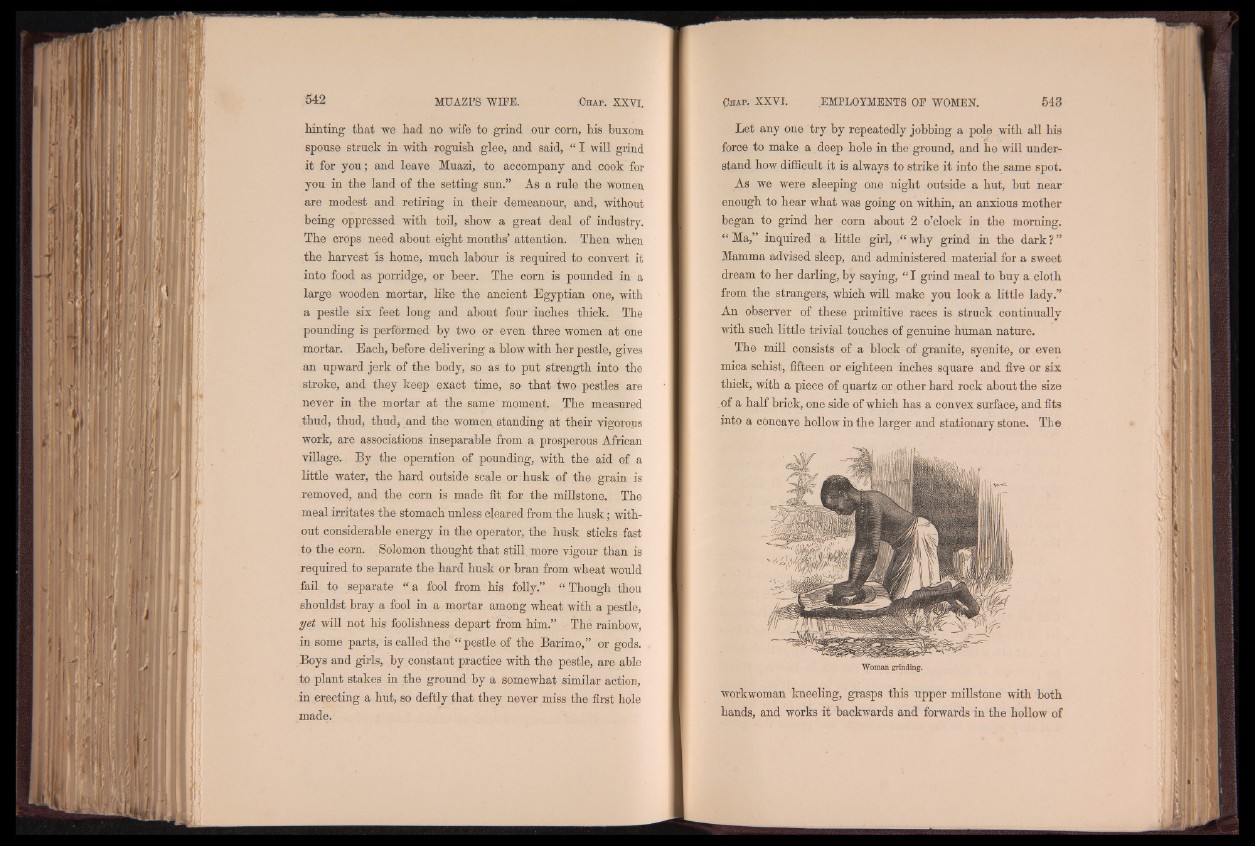
hinting that we had no wife to grind our corn, his buxom
spouse struck in with roguish glee, and said, “ I will grind
it for you; and leave Muazi, to accompany and cook for
you in the land of the setting sun.” As a rule the women
are modest and retiring in their demeanour, and, without
being oppressed with toil, show a great deal of industry.
The crops need about eight months’ attention. Then when
the harvest is home, much labour is required to convert it
into food as porridge, or beer. The corn is pounded in a
large wooden mortar, like the ancient Egyptian one, with
a pestle six feet long and about four inches thick. The
pounding is performed by two or even three women at one
mortar. Each, before delivering a blow with her pestle, gives
an upward jerk of the body, so as to put strength into the
stroke, and they keep exact time, so that two pestles are
never in the mortar at the same moment. The measured
thud, thud, thud, and the women standing at their vigorous
work, are associations inseparable from a prosperous African
village. By the operation of pounding, with the aid of a
little water, the hard outside scale or husk of the grain is
removed, and the corn is made fit for the millstone. The
meal irritates the stomach unless cleared from the husk; without
considerable energy in the operator, the husk sticks fast
to the corn. Solomon thought that still more vigour than is
required to separate the hard husk or bran from wheat would
fail to separate “ a fool from his folly.” “ Though thou
shouldst bray a fool in a mortar among wheat with a pestle,
yet will not his foolishness depart from him.” The rainbow,
in some parts, is called the “ pestle of the Barimo,” or gods.
Boys and girls, by constant practice with the pestle, are able
to plant stakes in the ground by a somewhat similar action,
in erecting a hut, so deftly that they never miss the first hole
made.
Let any one try by repeatedly jobbing a pole with all his
force to make a deep hole in the ground, and he will understand
how difficult it is always to strike it into the same spot.
As we were sleeping one night outside a hut, but near
enough to hear what was going on within, an anxious mother
began to grind her corn about 2 o’clock in the morning.
“ Ma,” inquired a little girl, why grind in the dark ? ”
Mamma advised sleep, and administered material for a sweet
dream to her darling, by saying, “ I grind meal to buy a cloth
from the strangers, which will make you look a little lady.”
An observer of these primitive races is struck continually
with such little trivial touches of genuine human nature.
The mill consists of a block of granite, syenite, or even
mica schist, fifteen or eighteen inches square and five or six
thick, with a piece of quartz or other hard rock about the size
.of a half brick, one side of which has a convex surface, and fits
into a concave hollow in the larger and stationary stone. The
Woman grinding.
workwoman kneeling, grasps this upper millstone with both
hands, and works it backwards and forwards in the hollow of